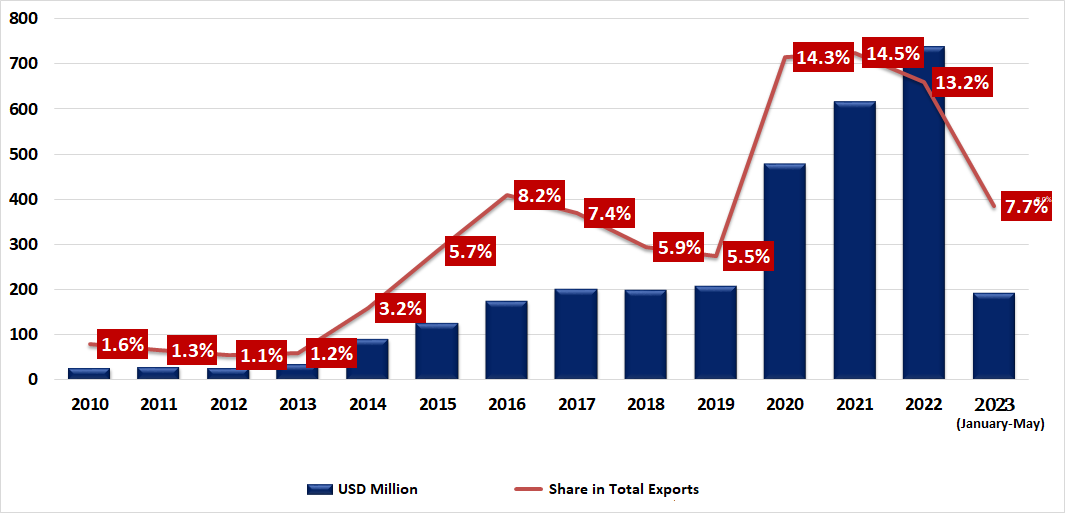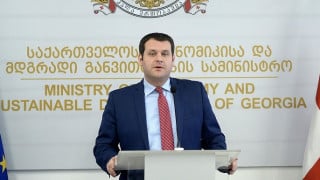Gennady Arveladze: “After the free trade agreement came into effect, export to China doubled.”
Verdict: FactCheck concludes that Gennady Arveladze’s statement is MOSTLY TRUE.
Resume: The free trade agreement with China came into effect in January 2018. Prior to the removal of tariffs, Georgia’s export to China was USD 202 million in 2017. In 2022, it reached USD 737 million which means growth by a factor of 3.65 and, therefore, it is more as compared to what the Deputy Minister of Economy says. In the same period, Georgia’s total export increased only 1.54 times.
Despite the massive growth of Georgia’s export to China in the reporting period, it is only partially attributable to the free trade agreement. In the previous five-year period when the free trade agreement was not into effect in 2012-2017, export to China increased 7.86 times from USD 25.7 million to USD 202 million. In addition, although the Georgia-China free trade agreement is now in effect, export to China dropped sharply by 46.7% in January-May 2023 as compared to the same period of the previous year from USD 363 million to USD 193 million. This was largely stipulated by a drop in demand and prices for one of Georgia’s major export items – copper ores.
The spirit of the Deputy Minister of Economy’s statement that export to China increased significantly after the free trade agreement came into effect is correct. However, an additional piece of information is missing, in particular – highlighting the fact that export to China used to grow substantially well before the free trade agreement came into effect. Therefore, it is possible that the export growth is not fully the result of the agreement. Given these circumstances, FactCheck concludes that Gennady Arveladze’s statement is MOSTLY TRUE.
Analysis
On 7 July 2023, at the first session of the joint Free Trade Commission of the Government of Georgia and the Government of China, Deputy Minister of Economy and Sustainable Development, Gennady Arveladze, spoke about the importance of the free trade agreement with China and the outcomes for the first five years, noting that: “The free trade agreement with China came into effect on 1 January 2018. After that, we see a trend of a significant growth of export to China. For instance, export to China has doubled.”
Until 2010, China’s share in Georgian export was negligible. In 1995-2009, the value of the total Georgian export to China was USD 50 million which constituted 0.56% of the country’s total export. In 2010, Georgia’s export to China increased 4.5 times from USD 6 million to USD 27 million. Another leap in trade was made in 2014 when the trade volume increased from USD 34 million to USD 90 million and growth continued in the coming years.
The free trade agreement with China came into effect in January 2018; however, the export value to China basically remained the same in 2018 and 2019 (it decreased from USD 202 million to USD 199 million in 2018 and rebounded to USD 207 million in 2019) whilst contracting in terms of the share of exports. China’s share in Georgia’s export was 7.35% in 2017 and decreased to 5.89% in 2018 and to a further 5.46% in 2019.
In 2020, export to China increased 2.3 times from USD 207 million to USD 477 million in light of the economic downturn and the shrinking foreign trade with most countries which made China Georgia’s top export partner with a 14.3% share in export.
China kept the position of Georgia’s top export partner in 2021 and 2022 as well. As a result of a decrease in January-May 2023, however, it dropped to the sixth position.
Graph 1: Export to China

Source: National Statistics Office of Georgia
Georgia mostly exports copper ores and concentrates to China. Since 2014, the share of the value of copper ores accounts for at least 74% of the total Georgian export value to China every year.
Massive dependence on one particular country or product is always risky. As opposed to Russia, China did not impose a trade ban, although the decreased demand and price for copper ores negatively affected their export. The export value of one tonne of copper ore and concentrates was USD 2,133 in 2022 and its price dropped to USD 1,870 in 2023.
Graph 2: Export Structure to China

Source: National Statistics Office of Georgia
In 2022, precious metals were the second largest export item to China with a value of USD 81 million, followed by medical equipment worth USD 22 million and the value of exported wine at USD 12.5 million which is only 1.7% of Georgia’s total export to China. In 2019, wine export to China reached USD 19 million and its share was 8.4%.
According to the data of the first five months of 2023, precious metals are again the second largest export item to China with a value of USD 22 million, followed by medical equipment worth USD 12 million and wine export again in the fourth position with a value of USD 5.1 million.
In January-May 2023, the values of copper ores and other products exported to China were USD 297 million and USD 66 million, respectively. In the same period of 2023, the value of copper ores was USD 144 million and other products accounted for USD 49 million. Although the export of other products also contracted, copper ores still account for the lion’s share in the drop of export.
All other things being equal, the abolition of tariffs and quotas does indeed incentivise foreign trade but a tariff policy does not decide everything. For export, it is also key to have a demand for a product and keeping the competitiveness of the exporter. In order to reduce risks, diversification is also important. In the case of China, halving the export was caused by an extremely high degree of dependence on copper ores.
The part of Gennady Arveladze’s statement where he speaks about the doubling of exports to China after signing the free trade agreement is true. However, it is also true that export to China was increasing rapidly well before this agreement came into effect as well as the fact that export to China was halved in the first five months of 2023lso under this agreement. Given the full context, FactCheck concludes that Gennady Arveladze’s statement is MOSTLY TRUE.








